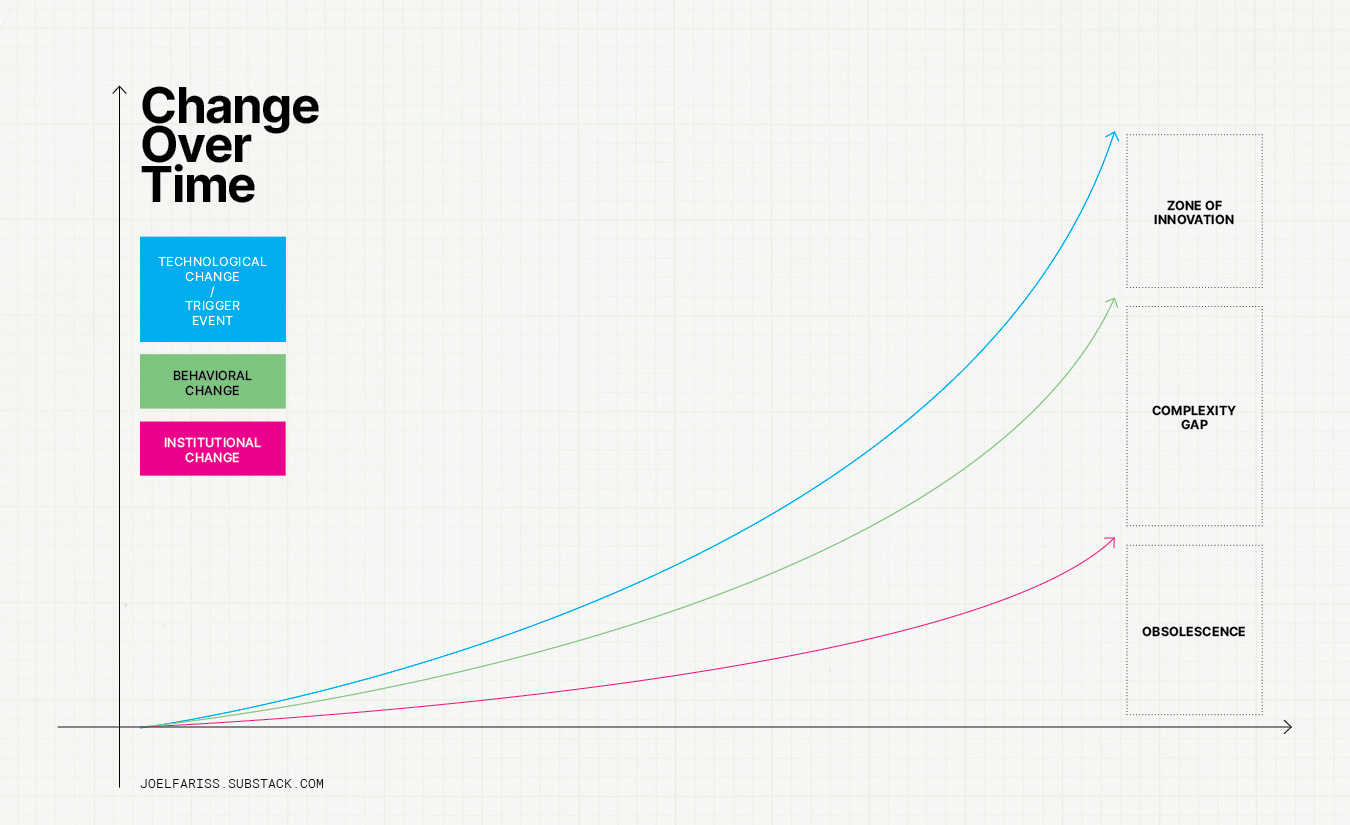
“People have changed more than the business organizations they depend upon for consumption and employment.” – Shoshana Zuboff, Professor, Harvard Business School
Trigger Events, the Complexity Gap, and Employee Expectations
Business cycles (from trough to peak to trough in regard to growth and decline) are driven by many factors, though most can be typified by an inability to navigate the complexity gap of evolving consumer-employee expectations (our experiences as consumers drive our expectations as employees). As illustrated in the visual above, trigger events (technological, social, and cultural) create new consumer-employee behaviors. These new behaviors cultivate new expectations for the organizations and systems on which our lives are lived. Organizations then must adapt to meet these new expectations. Though trigger events, and the subsequent behavior change they initiate, happen much faster than organizations have historically evolved. For example, Blockbuster Video was unable to navigate the complexity gap to meet new consumer demands for streaming. Likewise, companies like Hewlett Packard and Oracle have not been able to navigate the complexity gap of evolving employee needs for purpose and agency, rendering their workforces entrenched in outdated modes of working, effectively sentencing them to a slow decline. Amazon on the other hand has outrun the complexity gap by staying in the zone of innovation – anticipating consumer-employee expectations through relentless learning and iteration. Microsoft almost fell prey to the predator of obsolescence, but under the leadership of Satya Nadella has made great strides through the complexity gap (yet has a way to go).
The internet – the greatest trigger event of human history – and the subsequent mobile revolution introduced technologies that redefined how we as humans relate to each other, to knowledge and information, and to the world around us – suddenly we had new ways of connecting to communities that transcended proximity, and new ways of accessing knowledge regardless of its origin. Human socialization and access to knowledge had become distributed and decentralized. As with all new technology, consumers and employees alike adopted new and novel behaviors which cultivated new expectations of the organizations on which the depend for consumption and employment.
“The future is only complex if you fail to understand it from the point of view of what is driving the change.” – Helgo Tenno
Here’s where we get mixed up. COVID-19 hasn’t created a new complexity gap! The pandemic has merely forced thousands of companies to stare into the existing complexity gap and make a decision – do we find a way across or fall prey to obsolescence? Through the global work-from-home experiment of the last eight months, COVID-19 has radically amplified the pre-existing expectations that employees have of organizations, namely to adopt that which has become a normative aspect of life, learning, and community – decentralization. Just as it would be unimaginable to regress to a world without the internet, and the connectivity it affords, it is now impossible for employees to regress to a world without the flexibility that working from home has afforded. For the first time, an employees relationship to the organization mirrors the virtual heuristics of connectivity they have come to know and appreciate. Flexibility, mobility, choice, and autonomy were all latent employee-consumer expectations that have been affirmed by the market for the last 13 years. This is why the pandemic is a great opportunity to become a responsive organization – one that truly listens to the needs, desires, and aspirations of consumer-employees. Now is the time to design a business model, an operational model, and a management model that can effectively meet the market and social demands of the 21st century.
The imperative for organizations today is close the complexity gap – the delta between the expectations of employees and the organizational capacity to meet them. Those that effectively close the gap will emerge as the most attractive employers for the foreseeable future, and will likely become the most prosperous companies as a result. When the complexity gap is traversed, organizations access the zone of innovation in which they are positioned to define the future, not just for themselves, but for entire industries. Failing to traverse the complexity gap is a sure way to fall prey to obsolescence, a predator who uses a need for certainty and top down decision making as bait.
Resources for Further Learning
Link: Creating Value in the Age of Distributed Capitalism
Link: When the Iron Law of Efficiency Comes Crashing Down
Video: The Biggest Moments in Human History
Video: The Responsive Organization
Thanks for reading. I’d love to hear your thoughts – don’t hesitate to reach out with questions, comments, etc – joel@joelfariss.com. You can also follow me on instagram and twitter.
If you found the thoughts above interesting in a meaningful way, please forward this to one person – a friend, family member, or colleague – who’d also enjoy it. Or share others across one of your social networks, and let people know why you find this newsletter valuable. Just hit the share button!



